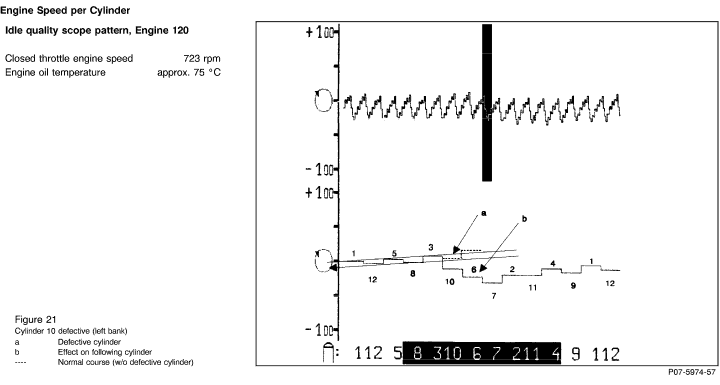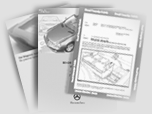General Information
The idle quality test allows more in-depth diagnosis of such engine complaints such as rough idle, missing when idling, or delayed starting time. The test scope is divided into:
 Idle quality, engine speed per cylinder, Idle quality, engine speed per cylinder,
 Idle quality, burn time per cylinder, Idle quality, burn time per cylinder,
 Idle quality, while starting. Idle quality, while starting.
The methods for using each test sequence are explained on the following pages.
It is necessary in all three test sequences to evaluate the tabular examples and/or the graphic examples. The two should be compared and checked for agreement.

When evaluating the idle quality measurement, the following should be noted according to the number of cylinders the engine has: |
 |
 |
 |
 |
 |
 |
 |
 |
 |
Engine Speed per Cylinder
The "Engine Speed per Cylinder" table clearly shows that the cylinder with the lowest engine speed is the weakest.
As a result, the measured value is well suited as a confirmation in cases of frequent missing which can not be identified with certainty by use of the engine speed graphic example.
Since these values represent an average of individual values, intermittent missing can not be identified.
Intermittent misses can only be identified and evaluated by means of the sample graphic illustration.
Before starting repair work based on test results, the vehicle should be evaluated from the driver's seat and compared to typical production vehicles.
(Vehicles with automatic transmissions should be evaluated with the transmission in a drive range.)
In such a case, test results can not replace individual judgment and the experience of a specialist.
a) 4-cylinder engine, example 1
In principle, the average engine speed change or average engine speed difference measurements should not be used to diagnose
4-cylinder engines for reasons of measuring technique.
The reason is:
The average speed change value of a properly functioning cylinder can indicate a high speed drop of the following cylinder, thereby leading to a false diagnosis.
In case of a failure, the average speed change value on 4-cylinder engines can not clearly indicate the defective cylinder.
|
Engine Speed per Cylinder
Idle quality table - Engine 102/111, Example 1
| Cylinder |
Average engine speed |
Average engine speed change |
| 1 |
785 |
1 |
| 3 |
776 |
- 9 |
| 4 |
784 |
8 |
| 2 |
784 |
0 |
| Max |
785 |
|
| Min |
776 |
|
| Difference |
9 |
|
Note:
Brief or intermittent misfires can not be recognized from the table, for this
purpose, the scope pattern must be used to identify the defective cylinder.
The column "Average engine speed change" must not be used for the
evaluation. A clear statement is only possible via the Average engine speed. |
Engine Speed per Cylinder
Table Idle quality - Engine 102/111, Example 2
| Cylinder |
Average engine speed |
Average engine speed change |
| 1 |
999 |
5 |
| 3 |
994 |
- 5 Incorrect reading |
| 4 |
976 |
- 18 Defective cylinder |
| 2 |
994 |
18 |
| Max |
999 |
|
| Min |
976 |
|
| Difference |
23 |
|
Note:
Brief or intermittent misfires can not be recognized from the table, for this
purpose, the scope pattern must be used to identify the defective cylinder.
The column "Average e purpose, the scope pattern must be used to identify the defective cylinder.
The column "Average engine speed change" must not be used for the
evaluation. A clear statement is only possible via the Average engine speed. |
Engine Speed per Cylinder
Table Idle quality - Engine 102 with Tandem Mass Flywheel, Example 3
| Cylinder |
Average engine speed |
Average engine speed change |
| 1 |
753 |
- 1 |
| 3 |
750 |
- 3 |
| 4 |
739 |
- 11 Defective cylinder |
| 2 |
754 |
15 |
| Max |
754 |
|
| Min |
739 |
|
| Difference |
15 |
|
Engine speed per cylinder
c) 6-Cylinder engine, Engine 103
In the example shown in the table below, the average engine speed for cylinder 6 is the lowest. The average engine speed change at cylinder 6 is clearly the greatest and can be used for the evaluation.
The engine speed drop is also clearly visible in the scope pattern.
|
Table Idle quality
| Cylinder |
Average engine speed |
Average engine speed change |
| 1 |
727 |
14 |
| 5 |
728 |
1 |
| 3 |
726 |
- 2 |
| 6 |
670 |
- 56 Defective cylinder |
| 2 |
698 |
28 |
| 4 |
713 |
15 |
| Max |
728 |
|
| Min |
670 |
|
| Difference |
58 |
|
Engine Speed per Cylinder
d) 8-Cylinder engine, Engine 116/117
In principle, the average engine speed change or average engine speed difference value measured should not be used for diagnosis of 8 cylinder engines.
Cause:
The engine speed difference value can indicate an excessive engine speed drop on the cylinder following a strong cylinder, thus leading to a faulty diagnosis.
The engine speed difference value can not be traced with certainty to the defective cylinder .
In the example shown in the table, the average engine speed for cylinder 6 is the lowest. However, the average engine speed change for cylinder 8 is the greatest.
Since the greatest engine speed drop occurs at cylinder 8, cylinder 8 is the defective cylinder. Cylinder 6, which follows, is affected by cylinder 8 and should be ignored. |
Table Idle quality
| Cylinder |
Average engine speed |
Average engine speed change |
| 1 |
704 |
4 |
| 5 |
712 |
8 |
| 4 |
720 |
8 |
| 8 |
686 |
- 34 Defective cylinder |
| 6 |
668 |
- 18 Effect from cylinder 8 |
| 3 |
684 |
16 |
| 7 |
695 |
11 |
| 2 |
700 |
5 |
| Max |
720 |
|
| Min |
668 |
|
| Difference |
52 |
|
Engine Speed per Cylinder
e) 8-Cylinder Engine, Engine 119
Table Idle quality
| Cylinder |
Average engine speed |
Average engine speed change |
| 1 |
658 |
3 |
| 5 |
656 |
- 2 |
| 4 |
660 |
4 |
| 8 |
658 |
- 2 |
| 6 |
659 |
1 |
| 3 |
656 |
- 3 |
| 7 |
660 |
4 |
| 2 |
655 |
- 5 |
| Max |
660 |
|
| Min |
655 |
|
| Difference |
5 |
|
Engine Speed per Cylinder
f) 12-Cylinder Engine, Engine 120
Table Idle quality
| Cylinder |
Average engine speed |
Average engine speed change |
| 1 |
664 |
6 |
| 12 |
658 |
- 6 |
| 5 |
663 |
5 |
| 8 |
659 |
- 4 |
| 3 |
665 |
6 |
| 10 |
660 |
- 5 |
| 6 |
665 |
5 |
| 7 |
658 |
- 7 |
| 2 |
664 |
6 |
| 11 |
658 |
- 6 |
| 4 |
663 |
5 |
| 9 |
658 |
- 5 |
| Max |
665 |
|
| Min |
658 |
|
| Difference |
7 |
|
Engine Speed per Cylinder
f) 12-Cylinder Engine (Engine 120)
Table Idle quality
Cylinder 4 defective (right bank)
| Cylinder |
Average engine speed |
Average engine speed change |
| 1 |
716 |
11 |
| 12 |
712 |
- 4 |
| 5 |
723 |
11 |
| 8 |
721 |
- 2 |
| 3 |
732 |
11 |
| 10 |
730 |
- 2 |
| 6 |
740 |
10 |
| 7 |
734 |
- 6 |
| 2 |
743 |
9 |
| 11 |
737 |
- 6 |
| 4 |
730 |
- 7 Defective cylinder |
| 9 |
705 |
- 25 Effect on following cylinder |
| Max |
743 |
|
| Min |
705 |
|
| Difference |
38 |
|
Engine Speed per Cylinder
f) 12-Cylinder Engine, Engine 120
Table Idle quality
Cylinder 10 defective (left bank)
| Cylinder |
Average engine speed |
Average engine speed change |
| 1 |
743 |
11 |
| 12 |
739 |
- 4 |
| 5 |
748 |
9 |
| 8 |
744 |
- 4 |
| 3 |
752 |
8 |
| 10 |
734 |
- 18 Defective cylinder |
| 6 |
722 |
-12 Effect on following cylinder |
| 7 |
717 |
- 5 |
| 2 |
727 |
10 |
| 11 |
724 |
- 3 |
| 4 |
735 |
11 |
| 9 |
732 |
- 3 |
| Max |
752 |
|
| Min |
717 |
|
| Difference |
35 |
|
 |
Burn Time per Cylinder
(only with Bear engine analyzer)
This test is intended as an initial measurement similar to the idle quality test. Positive or negative variations, which always occur at the same cylinder, indicate a problem in the ignition system which will not always necessarily result in an engine speed drop. However, engine missing may occur at higher mileage.

Burn time per cylinder, Engine 104/111 HFM-SFI can be tested with HHT starting 01/94.
Major positive or negative variations may be caused by carbon fouled spark plugs (e. g. short-distance driving).
The vehicle should be driven for a longer distance to obtain a more exact diagnosis.
The variations shown in the table do not result in an unacceptable engine speed drop.
|
Table Idle quality, Engine 102
| Cylinder |
Average engine speed |
Average engine speed change |
| 1 |
683 |
- 4 |
| 3 |
684 |
1 |
| 4 |
686 |
2 |
| 2 |
687 |
1 |
| Max |
687 |
|
| Min |
683 |
|
| Difference |
4 - Difference value still acceptable |
|
Burn Time per Cylinder
Variations >± 0.5 ms per cylinder should be confirmed by additional measurements such as oscilloscope and secondary ignition system table.
|
The example shows a 4 cylinder engine
Idle quality table, Engine 102
| Cylinder |
Average engine speed |
Average engine speed change |
| 1 |
1056 |
17 |
| 3 |
1051 |
- 5 |
| 4 |
1047 |
- 4 |
| 2 |
1039 |
- 8 |
| Max |
1056 |
|
| Min |
1039 |
|
| Difference |
17 |
|
|


 Printable version
Printable version


 Printable version
Printable version